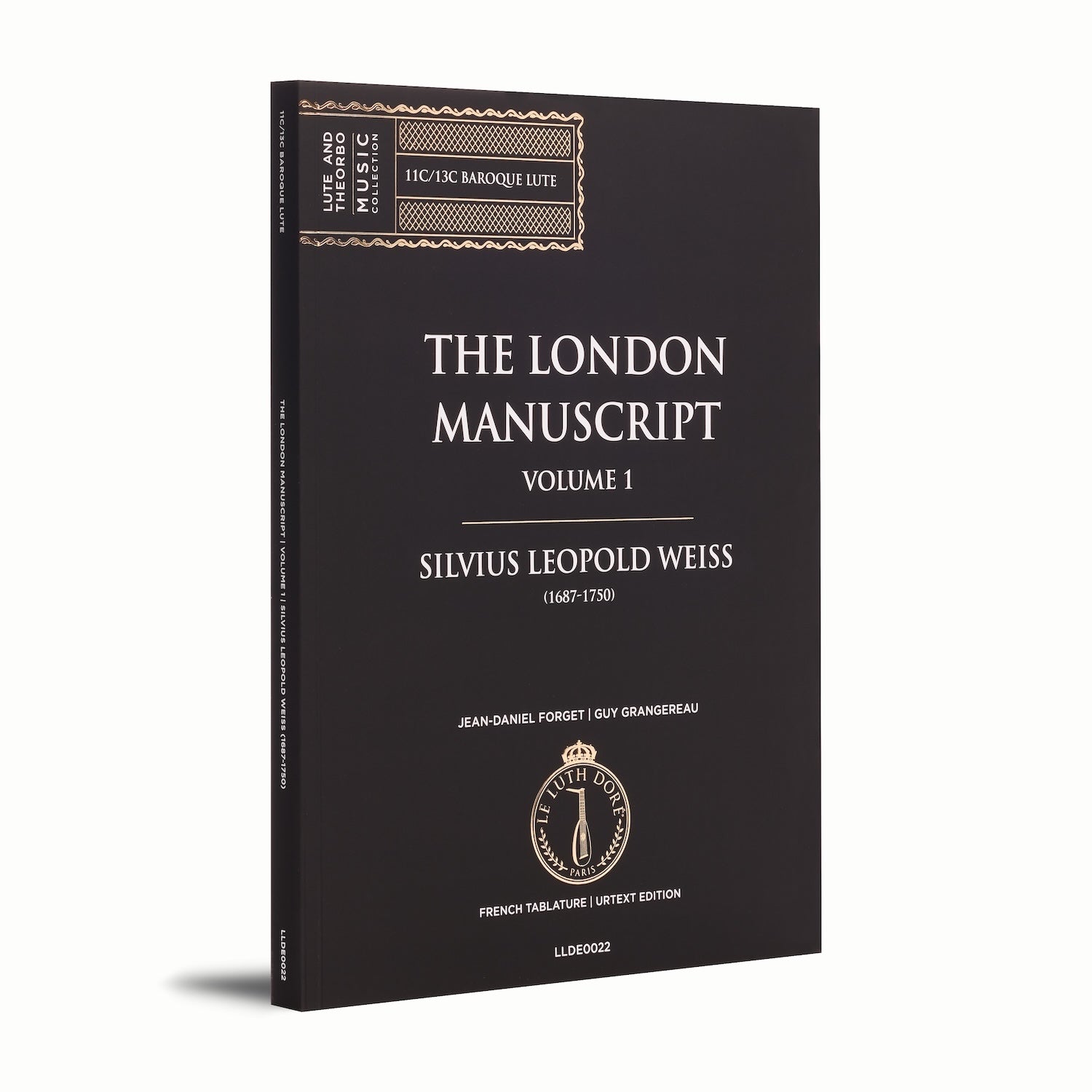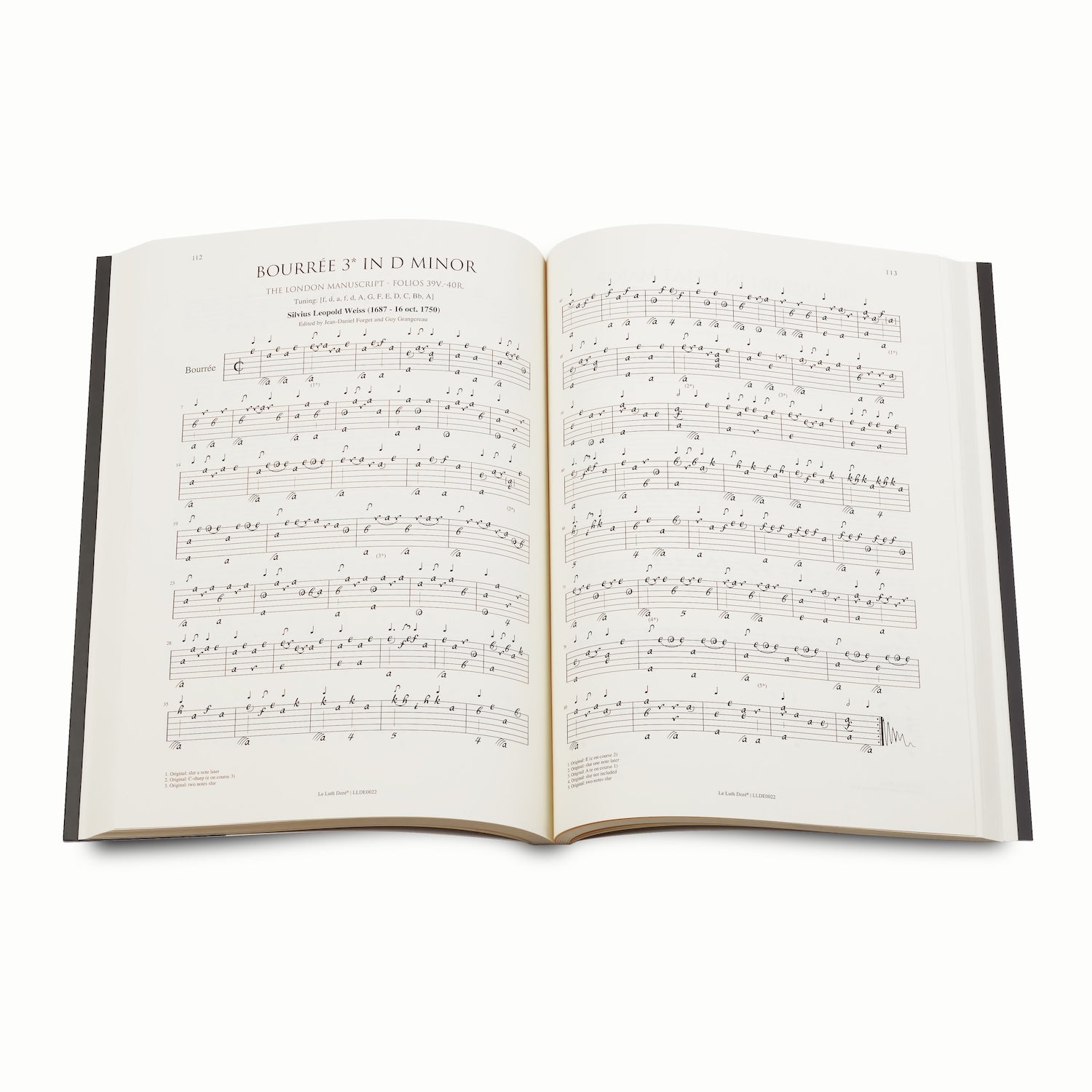My Store
The London Manuscript | Volume I
The London Manuscript | Volume I
SKU:LLDE0022
• Composer(s): Silvius Leopold Weiss (1687-1750)
• Title: The London Manuscript
• Year of publication: c.1717-1723
• Source: GB-Lbl Add. Ms. 30387
• Volume: I
• Scholarly edition based on original sources
• Accurate transcriptions, historical fingering, optimal readability
• Ideal for concerts, research, or higher education
No VAT applied (Article 293 B of the French Tax Code).
Couldn't load pickup availability
Partager

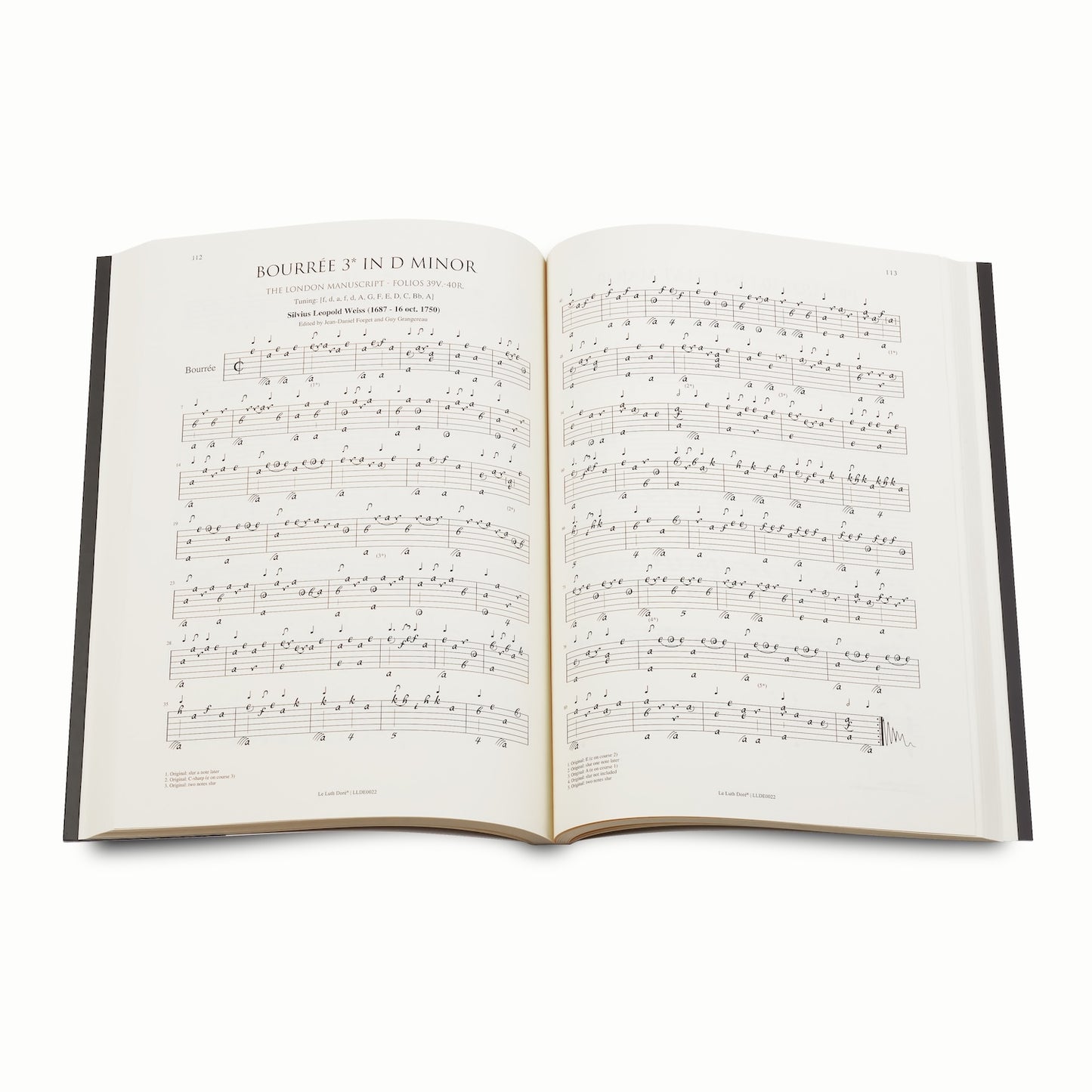
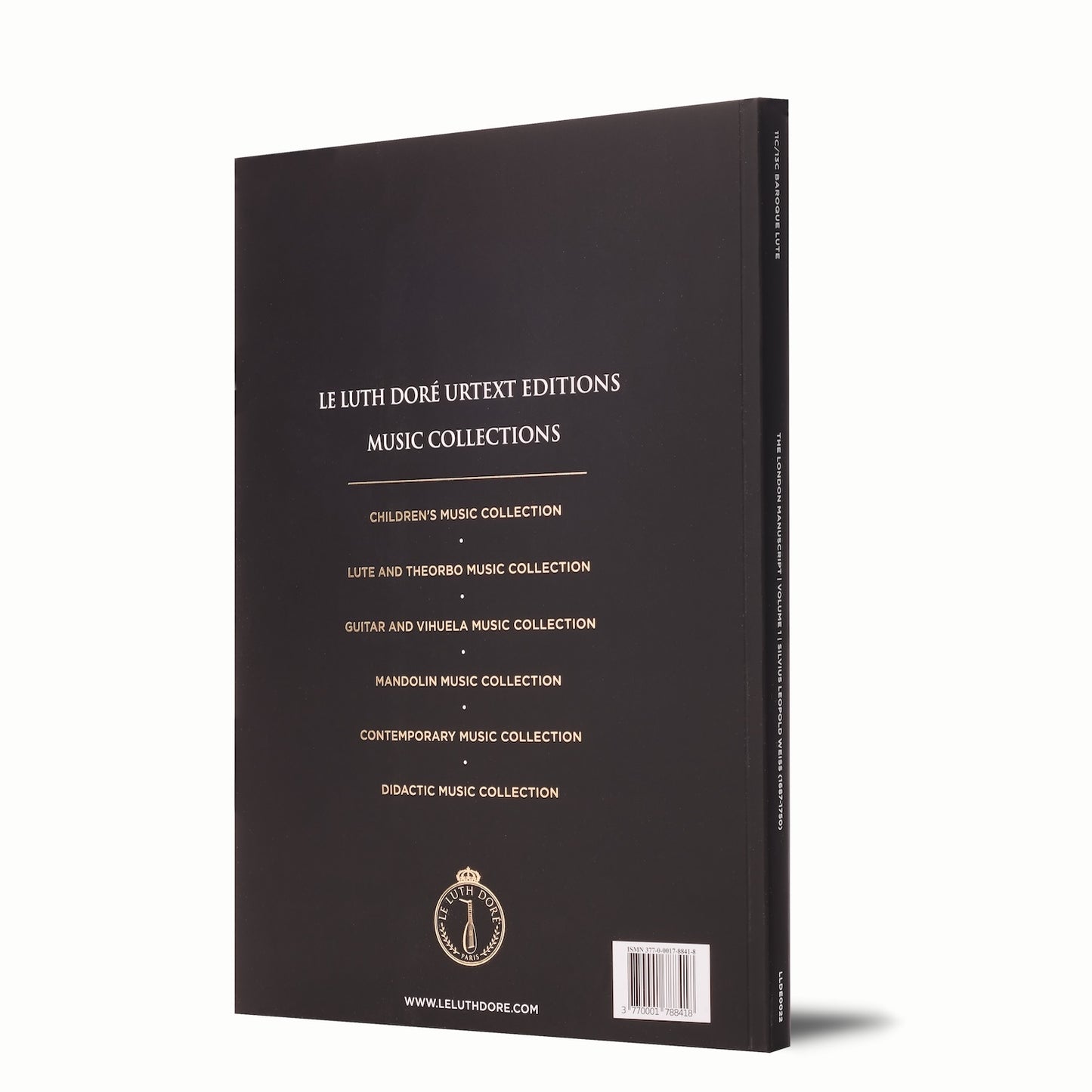
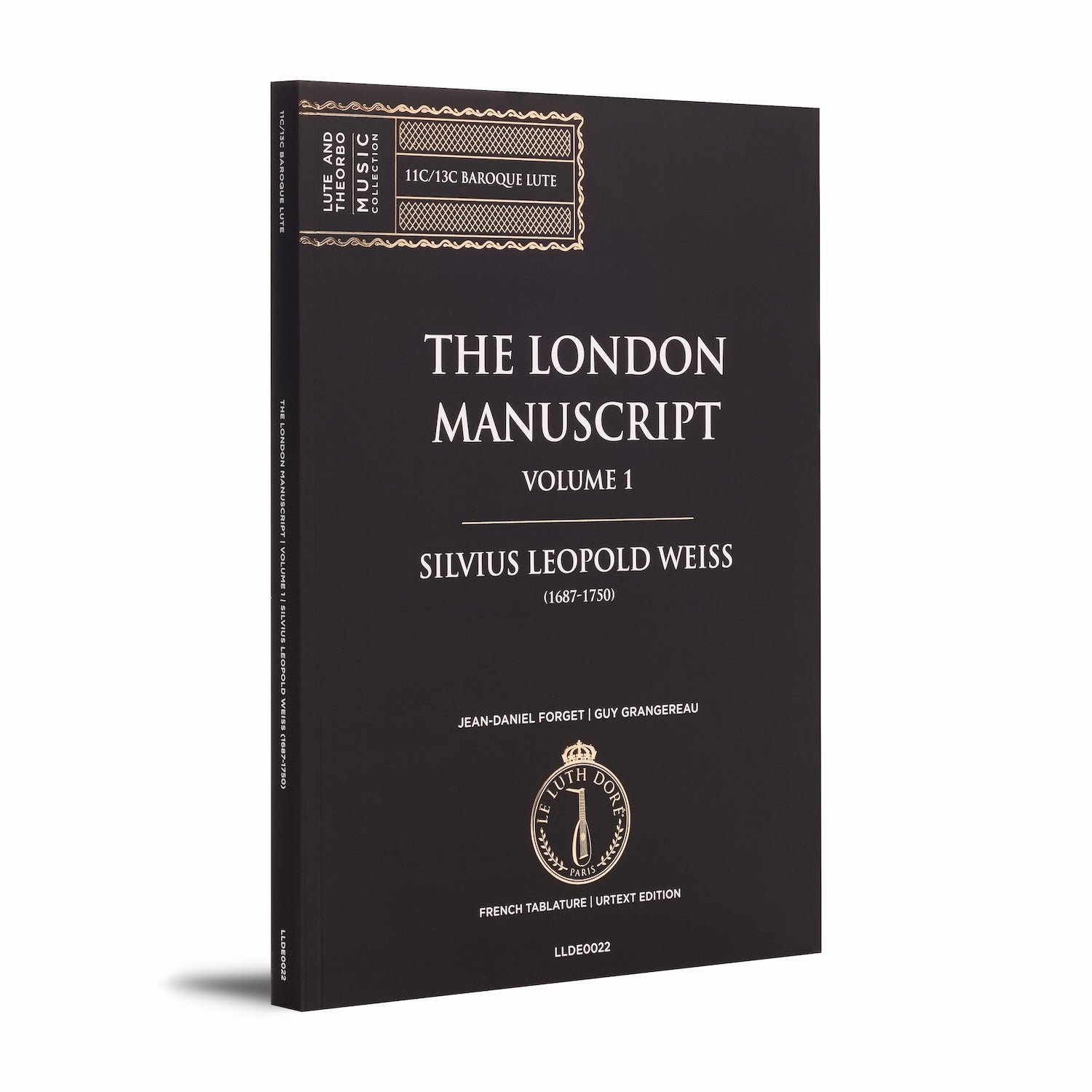
Weiss in London: Between Counterpoint and Galanterie
The first volume in a collection dedicated to Silvius Leopold Weiss, this edition gathers complete sonatas and individual pieces from the London Manuscript, presented in a faithful and critical transcription.
These works illustrate the composer’s stylistic maturity, the evolution of the thirteen-course Baroque lute, and the grounding of his writing in counterpoint, galant elegance, and rhetorical expressiveness. Edition by Jean-Daniel Forget and Guy Grangereau.
Product Details
Overview
The London Manuscript by Silvius Leopold Weiss
The London Manuscript, preserved at the British Library under the shelfmark Additional MS 30387, is a 317-page collection of French tablature for the Baroque lute with 11, 12, or 13 courses. Composed primarily of works by Silvius Leopold Weiss, it contains 26 complete sonatas, as well as preludes, fugues, fantasias, tombeaux, and ensemble pieces, including three concertos for lute and transverse flute.
Annotations indicate that the manuscript was compiled in Prague between 1717 and 1723, a period during which Weiss maintained close ties with the local nobility and musicians. The presence of multiple copyists—including Weiss himself—suggests a gradual process of compilation. Research by Douglas Alton Smith and Claire Madl attributes the collection to Johann Christian Anthoni von Adlersfeld, a Prague merchant and music enthusiast.
Organized chronologically, the pieces reflect the evolution of the lute toward the galant style. From 1719 onward, they were conceived specifically for a 13-course lute. Since the 1980s, the works have been catalogued according to the WeissSW system, facilitating their identification. This manuscript remains a major source for understanding Weiss’s music and his influence on the eighteenth-century lute repertoire.
Editors
Jean-Daniel Forget – IT Specialist, Lutenist
Passionate about the Baroque repertoire, Jean-Daniel Forget is a self-taught lutenist who has been copying and distributing early music manuscripts for nearly twenty years. A professional IT specialist, he is proficient in music notation software adapted to tablature. In collaboration with Guy Grangereau, he shares tablatures on a dedicated website. He also assisted Miguel Serdoura in preparing his editions and his Baroque Lute Method.
Guy Grangereau – Guitarist, Lutenist
A professional musician, Guy Grangereau studied guitar in Paris with Turibio Santos before furthering his training at the Martenot school. He taught for twenty years and now performs on a 16-string hybrid instrument and a theorboed baroque lute. Since 2010, he has collaborated with Jean-Daniel Forget in transcribing and revising Baroque manuscripts, particularly those of Silvius Leopold Weiss.
Urtext Editions
Le Luth Doré Urtext Editions
Le Luth Doré Urtext Editions offer scores faithful to historical sources, optimized for musicians and musicologists. Our editions combine careful engraving, practical layout, durable materials, and a detailed critical apparatus in multiple languages.
Each text is rigorously established note by note to ensure an authentic restitution of the works, including original fingerings and ornamentations, as well as relevant stylistic suggestions.
Prepared by experts, our editions provide clear readability and informed interpretation of the early music repertoire.
We dedicate Le Luth Doré Urtext Editions to the memory of William H. Roberts († 2024), cofounder and source of inspiration for this collection. Without his vision and unwavering support, these editions would never have come into being.
Technical Details
• Editor(s): Jean-Daniel Forget & Guy Grangereau
• Musical period: Baroque
• Instrument(s): 11c/13c Baroque lute
• Instrumentation: Solo Baroque lute
• Notation: French tablature
• Modern edition: Urtext
• Publisher: Le Luth Doré Urtext Editions
• Year of publication: 2021
• Series: Lute and Theorbo Music Collection
• Pages: 300 pp.
• Dimensions: 230 × 310 mm
• Weight: 0.924 kg
• Binding: Sewn perfect binding
• Cover: Soft cover with flaps, anti-scratch lamination, gold stamping, and spot varnish
• ISMN: 377-0-0017-8841-8
Table of Contents
Sonata 1 (F Major): Prelude, Allemande, Courante, Bourrée, Sarabande, Minuet, Gigue, Minuet, Gavotte
Sonata 2 (D Major): Prelude, Allemande, Courante, Bourrée, Sarabande, Minuet, Gigue, Gavotte, Double
Sonata 3 (G minor): Prelude, Allemande, Courante, Bourrée, Sarabande, Minuet, Minuet 2do
Short fragment (B flat major): [Anonymous]
Sonata 4 (B flat major): Prelude, Overture (Allegro & Presto), Courante, Bourrée
Allegro 1 (G Major)* : Allegro
Courante 2 (G Major)*: Royal Current
Sonata 5 (G Major): Prelude, Allemande, Courante, Bourrée, Sarabande, Minuet, Gigue
Sonata 6 (B flat major): Concert for lute & transverse flute (Weis) – Adagio, Allegro, Grave, Allegro
Sonata 7 (C minor): German, Courante, Gavotte, Sarabande, Minuet, Gigue
Sonata 8 (B flat major): Concert for lute & transverse flute (Sigismundo Weis) – Andante, Presto, Andante, Allegro
Sonata 9 (F Major): Concert for lute & transverse flute (SL Weis) – Adagio, Allegro, Amoroso, Allegro
Bourrée 3 (D minor)* : Stuffed
Prelude 10.1 (E flat major): Prelude
Sonata 10 (E flat major): Prelude, Allemande, Courante, Bourrée, Sarabande, Minuet, Chaconne
Minuet 4 (G Major)* : [Anonymous piece]
Sonata 11 (D minor): German, Courante, Gavotte, Sarabande, Minuet, Gigue
Sonata 12 (A Major): Allemande, Courante, Bourrée, Sarabande, Minuet, Chaconne, Gigue
Sonata 13 (D minor): Prelude, Allemande, Courante, Bourrée, Minuet
Largo 5 (D minor)* : Long
Fugue 6 (C Major)* : Fugue
Sonata 14 (G minor): Adagio, Gavotte, Sarabande, Minuet, Bourrée, Chaconne
Fugue 7 (D minor)* : Fugue
German 8 (A minor)* :The Unhappy Lover
Fantasy 9 (C minor)* : Fantasy
Minuet 10 (B flat major)* : [Anonymous piece]
Sonata 15 (B flat major):Mons Complaint: Weis– German, Common, Peasant, Sarabande, Minuet, Jig
Sonata 16 (A Major): German, Echo Air, Peasant, Sarabande, Minuet, Pastourelle
Sonata 17 (C Major): German, Common, Bourrée, Sarabande, Minuet, Peasant
Addendum
Fantasia 11.7 (D minor): Fantasia (Dresden Ms)
Prelude 12.8 (A Major): Prelude (Dresden Ms)
Bourrée 13.4 (D minor): Stuffed (Moscow Ms)
Press Reviews
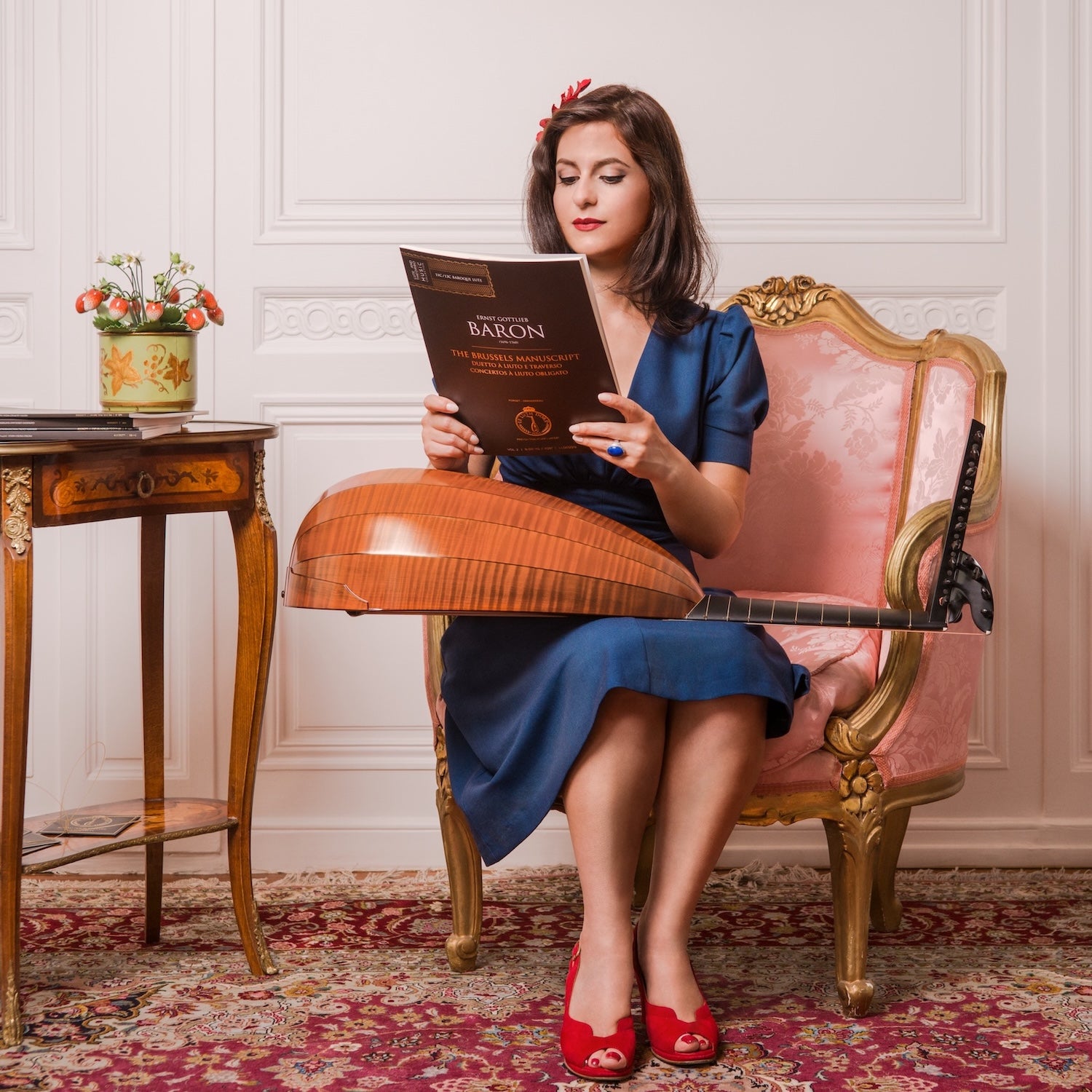
Editions for Baroque Lute
Each volume is crafted as a work of editorial art: high-quality printing, notation faithful to original sources, dual tablature (French and Italian), and rigorous critical apparatus.
Designed for today’s lutenists, these urtext editions embody the precision and elegance inherent to the art of the lute.

